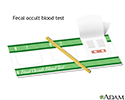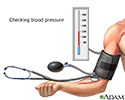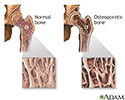Health screenings for men age 65 and older
Health maintenance visit - men - over age 65; Physical exam - men - over age 65; Yearly exam - men - over age 65; Checkup - men - over age 65; Men's health - over age 65; Preventive care exam - men - over age 65You should visit your health care provider regularly, even if you feel healthy. The purpose of these visits is to:
- Screen for medical issues
- Assess your risk for future medical problems
- Encourage a healthy lifestyle
- Update vaccinations and other preventive care services
- Help you get to know your provider in case of an illness
Information
Even if you feel fine, you should still see your provider for regular checkups. These visits can help you avoid problems in the future. For example, the only way to find out if you have high blood pressure is to have it checked regularly. High blood sugar and high cholesterol levels also may not have any symptoms in the early stages. A simple blood test can check for these conditions.
High blood pressure
Blood pressure is a measurement of the force exerted against the walls of your arteries as your heart pumps blood to your body. Hypertension is the ...

High cholesterol
Cholesterol is a fat (also called a lipid) that your body needs to work properly. Too much bad cholesterol in your blood can increase your chance of...

There are specific times when you should see your provider or receive specific health screenings. The US Preventive Services Task Force publishes a list of recommended screenings. Below are screening guidelines for men age 65 and older.
ABDOMINAL AORTIC ANEURYSM SCREENING
- If you are age 65 to 75 and have smoked, you should have an ultrasound to screen for abdominal aortic aneurysms.
Abdominal aortic aneurysms
The aorta is the main blood vessel that supplies blood to the abdomen, pelvis, and legs. An abdominal aortic aneurysm (AAA) occurs when an area of t...
 ImageRead Article Now Book Mark Article
ImageRead Article Now Book Mark Article - Other men should discuss this screening with their provider.
BLOOD PRESSURE SCREENING
Have your blood pressure checked at least once every year. Watch for blood pressure screenings in your area. Ask your provider if you can stop in to have your blood pressure checked. You can also check your blood pressure using the automated machines at some local grocery stores and pharmacies.
Blood pressure
Blood pressure is a measurement of the force on the walls of your arteries as your heart pumps blood through your body. You can measure your blood pr...

Ask your provider if you need your blood pressure checked more often if
- You have diabetes, heart disease, kidney problems, or are overweight or have certain other conditions
Heart disease
Coronary heart disease is a narrowing of the blood vessels that supply blood and oxygen to the heart. Coronary heart disease (CHD) is also called co...
 ImageRead Article Now Book Mark Article
ImageRead Article Now Book Mark ArticleKidney problems
Chronic kidney disease is the slow loss of kidney function over time. The main job of the kidneys is to remove wastes and excess water from the body...
 ImageRead Article Now Book Mark Article
ImageRead Article Now Book Mark Article - You have a first degree relative with high blood pressure
- You are Black
- Your blood pressure top number is from 120 to 129 mm Hg, or the bottom number is from 70 to 79 mm Hg
If the top number is 130 mm Hg or greater, but lower than 140 mm Hg or the bottom number is 80 mm Hg or greater but lower than 90 mm Hg, this is considered stage 1 hypertension. Readings above these are considered stage 2 hypertension. Schedule an appointment with your provider to learn how you can reduce your blood pressure. Record your blood pressure numbers and bring this information to share with your provider.
CHOLESTEROL SCREENING
If your cholesterol level is normal, your cholesterol should be checked every 5 years.
Repeat cholesterol testing or other additional monitoring should take place:
- Every 5 years for men with normal cholesterol levels
- More often if changes occur in lifestyle (including weight gain and diet)
- More often if you have diabetes, high blood pressure, heart disease, stroke, or blood flow problems in the legs or feet, or certain other conditions
Your provider may recommend testing more often if you are taking medicines to control high cholesterol.
COLORECTAL CANCER SCREENING
Until age 75, you should have screening for colorectal cancer on a regular basis. Several tests are available for colorectal cancer screening:
Colorectal cancer
Colorectal cancer is cancer that starts in the large intestine (colon) or the rectum (end of the colon). It is also sometimes simply called colon ca...

Colorectal cancer screening
Colon cancer screening can detect polyps and early cancers in the large intestine. This type of screening can find problems that can be treated befo...

- A stool-based fecal occult blood (FOBT) or fecal immunochemical test (FIT) every year (colonoscopy is needed if results are positive)
FIT
The fecal immunochemical test (FIT) is used as a screening test for colon cancer. It tests for hidden blood in the stool, which can be an early sign...
 ImageRead Article Now Book Mark Article
ImageRead Article Now Book Mark Article - A stool DNA-FIT test every 1 to 3 years (colonoscopy is needed if results are positive)
- Flexible sigmoidoscopy every 5 years or every 10 years with stool occult blood testing with FOBT or FIT every year
Sigmoidoscopy
Sigmoidoscopy using a flexible scope is a procedure used to see inside the sigmoid colon and rectum. The sigmoid colon is the area of the large inte...
 ImageRead Article Now Book Mark Article
ImageRead Article Now Book Mark Article - CT colonography (virtual colonoscopy) every 5 years
Virtual colonoscopy
A virtual colonoscopy (VC) is an imaging or x-ray test that looks for cancer, polyps, or other disease in the large intestine (colon). The medical n...
 ImageRead Article Now Book Mark Article
ImageRead Article Now Book Mark Article -
Colonoscopy every 10 years
Colonoscopy
A colonoscopy is an exam that views the inside of the colon (large intestine) and rectum, using a tool called a colonoscope. The colonoscope has a sm...
 ImageRead Article Now Book Mark Article
ImageRead Article Now Book Mark Article
You may need a colonoscopy more often if you have risk factors for colorectal cancer, such as:
-
Ulcerative colitis
Ulcerative colitis
Ulcerative colitis is a condition in which the lining of the large intestine (colon) and rectum become inflamed. It is a form of inflammatory bowel ...
 ImageRead Article Now Book Mark Article
ImageRead Article Now Book Mark Article - A personal or family history of cancer of the colon or rectum
- A history of growths in your colon called adenomatous polyps
Adenomatous polyps
A colorectal polyp is a growth on the lining of the colon or rectum.
 ImageRead Article Now Book Mark Article
ImageRead Article Now Book Mark Article - A family history of inherited colorectal cancer syndromes such as familial adenomatous polyposis (FAP) or hereditary nonpolyposis colorectal cancer (HNPCC)
- People ages 76 through 85 should talk with their health care provider about whether to continue to get screened. People ages 86 and older no longer need colorectal cancer screening.
DENTAL EXAM
- Go to the dentist once or twice every year for an exam and cleaning. Your dentist will evaluate if you have a need for more frequent visits.
PREDIABETES AND TYPE 2 DIABETES SCREENING
You should be screened for prediabetes and type 2 diabetes every 3 years up to age 70 if you are overweight or have obesity.
Prediabetes
Prediabetes occurs when the level of sugar (glucose) in your blood is too high, but not high enough to be called diabetes. If you have prediabetes, ...

Type 2 diabetes
Type 2 diabetes is a lifelong (chronic) disease in which there is a high level of sugar (glucose) in the blood. Type 2 diabetes is the most common f...

You should be tested more often if you have other risk factors for diabetes, such as:
- You have a first-degree relative with diabetes
Diabetes
Diabetes is a long-term (chronic) disease in which the body cannot regulate the amount of sugar in the blood.
 ImageRead Article Now Book Mark Article
ImageRead Article Now Book Mark Article - You have high blood pressure, prediabetes, or a history of heart disease
EYE EXAM
- Have an eye exam every year. Your provider may recommend more frequent eye exams if you have vision problems or glaucoma risk.
- Have an eye exam that includes an examination of your retina (back of your eye) at least every year if you have diabetes.
HEARING TEST
- Have your hearing tested if you have symptoms of hearing loss.
Hearing loss
Hearing loss is being partly or totally unable to hear sound in one or both ears.
 ImageRead Article Now Book Mark Article
ImageRead Article Now Book Mark Article
IMMUNIZATIONS
Commonly needed vaccines include:
- Flu shot: get one every year
- COVID-19 vaccine: ask you provider what is best for you
-
Pneumococcal vaccines
: you should receive the appropriate pneumococcal vaccines
Pneumococcal vaccines
All content below is taken in its entirety from the CDC Pneumococcal Polysaccharide Vaccine Information Statement (VIS): CDC review information for P...
 ImageRead Article Now Book Mark Article
ImageRead Article Now Book Mark Article - Shingles 2 doses of (herpes zoster) vaccine at or after age 50
- Tetanus-diphtheria and acellular pertussis (Tdap) vaccine: have as one of your tetanus-diphtheria vaccines if you did not receive it as an adolescent
- Tetanus-diphtheria: have a booster (Td or Tdap) every 10 years
INFECTIOUS DISEASE SCREENING
Screening for hepatitis C:
- All adults ages 18 to 79 should get a one-time test for hepatitis C.
Hepatitis C
Hepatitis C is a viral disease that leads to swelling (inflammation) of the liver. Other types of viral hepatitis include:Hepatitis AHepatitis BHepat...
 ImageRead Article Now Book Mark Article
ImageRead Article Now Book Mark Article
Screening for human immunodeficiency virus (HIV): all people ages 15 to 65 should get a one-time test.
HIV
Human immunodeficiency virus (HIV) is the virus that causes acquired immunodeficiency syndrome (AIDS). When a person becomes infected with HIV, the ...

Depending on your lifestyle and medical history, you may need to be screened for infections such as syphilis, chlamydia, and other infections.
LUNG CANCER SCREENING
You should have an annual screening for lung cancer with low-dose computed tomography (LDCT) if:
Lung cancer
Lung cancer is cancer that starts in the lungs. The lungs are located in the chest. When you breathe, air goes through your nose, down your windpipe...

- You are age 50 to 80 years AND
- You have a 20 pack-year smoking history AND
- You currently smoke or have quit within the past 15 years
OSTEOPOROSIS SCREENING
- If you have risk factors for osteoporosis, you should discuss screening with your provider.
Osteoporosis
Osteoporosis is a disease in which bones become fragile and more likely to break (fracture).
 ImageRead Article Now Book Mark Article
ImageRead Article Now Book Mark Article - Risk factors can include long-term steroid use, low body weight, smoking, heavy alcohol use, having a fracture after age 50, or a family history of hip fracture or osteoporosis.
PHYSICAL EXAMS
All adults should visit their provider from time to time, even if they are healthy. The purpose of these visits is to:
- Screen for diseases
- Assess risk of future medical problems
- Encourage a healthy lifestyle
- Update vaccinations and other preventive care services
- Maintain a relationship with a provider in case of an illness
In addition:
- Your blood pressure should be checked at least every year.
- Your height, weight, and body mass index (BMI) should be checked at every exam.
Body mass index (BMI)
A good way to decide if your weight is healthy for your height is to figure out your body mass index (BMI). You and your health care provider can us...
 ImageRead Article Now Book Mark Article
ImageRead Article Now Book Mark Article
During your exam, your provider may ask you about:
- Depression and anxiety
- Diet and exercise, including exercises to improve your balance and reduce your risk of falling
- Alcohol and tobacco use
- Safety, such as use of seat belts and smoke detectors and intimate partner violence
- Whether you have had any falls or are afraid of falling
- Your medicines and risk for interactions
PROSTATE CANCER SCREENING
If you're 55 through 69 years old, before having the test, talk to your provider about the pros and cons of having a prostate specific antigen (PSA) blood test. Ask about:
PSA
Prostate-specific antigen (PSA) is a protein produced by prostate cells. The PSA test is done to help screen for and monitor prostate cancer in men....

- Whether screening decreases your chance of dying from prostate cancer.
Prostate cancer
Prostate cancer is cancer that starts in the prostate gland. The prostate is a small, walnut-shaped structure that makes up part of a man's reproduc...
 ImageRead Article Now Book Mark Article
ImageRead Article Now Book Mark Article - Whether there is any harm from prostate cancer screening, such as side effects from testing or overtreatment of cancer when discovered.
- Whether you have a higher risk of prostate cancer than others.
For men 70 or older, most recommendations are against screening.
If you choose to be tested, the PSA blood test is repeated over time (yearly or less often), though the best frequency is not known.
- Prostate physical examinations are no longer routinely done on men with no symptoms.
SKIN EXAM
Your provider may check your skin for signs of skin cancer, especially if you're at high risk. You may be at risk if you:- Have had skin cancer before
- Have close relatives with skin cancer
- Have a weakened immune system
TESTICULAR EXAM
- The US Preventive Services Task Force (USPSTF) now recommends against performing testicular self-exams. Doing testicular self-exams has been shown to have little to no benefit.
References
American Academy of Ophthalmology website. Clinical statement: Comprehensive adult medical eye examination PPP 2020. www.aao.org/education/preferred-practice-pattern/comprehensive-adult-medical-eye-evaluation-ppp. Updated November 2020. Accessed June 11, 2024.
American Dental Association website. Your top 9 questions about going to the dentist - answered. www.mouthhealthy.org/en/dental-care-concerns/questions-about-going-to-the-dentist. Accessed June 11, 2024.
American Diabetes Association Professional Practice Committee. 2. Diagnosis and Classification of Diabetes: Standards of Care in Diabetes-2024. Diabetes Care. 2024;47(Suppl 1):S20-S42. PMID: 38078589 pubmed.ncbi.nlm.nih.gov/38078589/.
Barton MB, Wolff TA. The preventive health visit. In: Goldman L, Cooney K, eds. Goldman-Cecil Medicine. 27th ed. Philadelphia, PA: Elsevier; 2024:chap 12.
Centers for Disease Control and Prevention website. Vaccines & Immunizations. www.cdc.gov/vaccines/hcp/imz-schedules/adult-age.html. Adult Immunization Schedule by Age (Addendum updated June 27, 2024). Recommendations for Ages 19 Years or Older, United States, 2024. Updated November 16, 2023. Accessed September 16, 2024.
Grundy SM, Stone NJ, Bailey AL, et al. 2018 AHA/ACC/AACVPR/AAPA/ABC/ACPM/ADA/AGS/APhA/ASPC/NLA/PCNA Guideline on the Management of Blood Cholesterol: A Report of the American College of Cardiology/American Heart Association Task Force on Clinical Practice Guidelines [published correction appears in J Am Coll Cardiol. 2019;25;73(24):3237-3241]. J Am Coll Cardiol. 2019;73(24):e285-e350. PMID: 30423393 pubmed.ncbi.nlm.nih.gov/30423393/.
Meschia JF, Bushnell C, Boden-Albala B, et al. Guidelines for the primary prevention of stroke: a statement for healthcare professionals from the American Heart Association/American Stroke Association. Stroke. 2014;45(12):3754-3832. PMID: 25355838 pubmed.ncbi.nlm.nih.gov/25355838/.
Mora S, Libby P, Ridker PM. Primary prevention of cardiovascular disease. In: Libby P, Bonow RO, Mann DL, Tomaselli GF, Bhatt DL, Solomon SD, eds. Braunwald's Heart Disease: A Textbook of Cardiovascular Medicine. 12th ed. Philadelphia, PA: Elsevier; 2022:chap 25.
US Preventive Services Task Force website. Falls prevention in community-dwelling older adults: Interventions. www.uspreventiveservicestaskforce.org/uspstf/recommendation/falls-prevention-community-dwelling-older-adults-interventions. Published June 4, 2024. Accessed June 11, 2024.
US Preventive Services Task Force website. Final recommendation statement. Colorectal cancer: Screening. www.uspreventiveservicestaskforce.org/uspstf/recommendation/colorectal-cancer-screening. Published May 18, 2021. Accessed June 11, 2024.
US Preventive Services Task Force website. Final recommendation statement. Hepatitis C virus infection in adolescents and adults: Screening. www.uspreventiveservicestaskforce.org/uspstf/recommendation/hepatitis-c-screening. Published March 2, 2020. Accessed June 11, 2024.
US Preventive Services Task Force website. Final recommendation statement. Human immunodeficiency virus (HIV) infection: Screening. www.uspreventiveservicestaskforce.org/uspstf/recommendation/human-immunodeficiency-virus-hiv-infection-screening. Published June 11, 2019. Accessed June 11, 2024.
US Preventive Services Task Force website. Hypertension in adults: Screening. www.uspreventiveservicestaskforce.org/uspstf/recommendation/hypertension-in-adults-screening. Published April 27, 2021. Accessed June 11, 2024.
US Preventive Services Task Force website. Final recommendation statement: Lung cancer: Screening. www.uspreventiveservicestaskforce.org/uspstf/recommendation/lung-cancer-screening. Updated March 9, 2021. Accessed June 11, 2024.
US Preventive Services Task Force website. Final recommendation statement: Osteoporosis to prevent fracture: Screening. www.uspreventiveservicestaskforce.org/uspstf/recommendation/osteoporosis-screening. Updated June 26, 2018. Accessed June 11, 2024.
US Preventive Services Task Force website. Prediabetes and type 2 diabetes: Screening. www.uspreventiveservicestaskforce.org/uspstf/recommendation/screening-for-prediabetes-and-type-2-diabetes. Updated August 24, 2021. Accessed June 11, 2024.
US Preventive Services Task Force website. Final recommendation statement. Prostate cancer: Screening. www.uspreventiveservicestaskforce.org/uspstf/recommendation/prostate-cancer-screening. Updated May 8, 2018. Accessed June 11, 2024.
US Preventive Services Task Force website. Skin cancer: Screening. www.uspreventiveservicestaskforce.org/uspstf/recommendation/skin-cancer-screening. Updated April 18, 2023. Accessed June 11, 2024.
US Preventive Services Task Force website. Testicular cancer: Screening. www.uspreventiveservicestaskforce.org/uspstf/recommendation/testicular-cancer-screening. Published April 15, 2011. Accessed June 11, 2024.
Whelton PK, Carey RM, Mancia G, Kreutz R, Bundy JD, Williams B. Harmonization of the American College of Cardiology/American Heart Association and European Society of Cardiology/European Society of Hypertension Blood Pressure/Hypertension Guidelines: Comparisons, Reflections, and Recommendations. Circulation. 2022;146:868–877. PMID: 35950927
pubmed.ncbi.nlm.nih.gov/35950927/.
-
Fecal occult blood test - illustration
A fecal occult blood test is a noninvasive test that detects the presence of hidden blood in the stool. Blood in the stool that is not visible is often the first, and in many cases the only, warning sign that a person has colorectal disease, including colon cancer.
Fecal occult blood test
illustration
-
Effects of age on blood pressure - illustration
Blood vessels become less elastic with age. The average blood pressure increases from 120/70 to 150/90 and may persist slightly high even if treated. The blood vessels respond more slowly to a change in body position.
Effects of age on blood pressure
illustration
-
Osteoporosis - illustration
Osteoporosis is a condition characterized by progressive loss of bone density, thinning of bone tissue and increased vulnerability to fractures. Osteoporosis may result from disease, dietary or hormonal deficiency or advanced age. Regular exercise and vitamin and mineral supplements can reduce and even reverse loss of bone density.
Osteoporosis
illustration
-
Prostate cancer - illustration
Prostate cancer is the most common cancer in men in the United States. Prostate cancer forms in the prostate gland, and can sometimes be felt on digital rectal examination. This is one of the purposes of the digital rectal exam.
Prostate cancer
illustration
-
Fecal occult blood test - illustration
A fecal occult blood test is a noninvasive test that detects the presence of hidden blood in the stool. Blood in the stool that is not visible is often the first, and in many cases the only, warning sign that a person has colorectal disease, including colon cancer.
Fecal occult blood test
illustration
-
Effects of age on blood pressure - illustration
Blood vessels become less elastic with age. The average blood pressure increases from 120/70 to 150/90 and may persist slightly high even if treated. The blood vessels respond more slowly to a change in body position.
Effects of age on blood pressure
illustration
-
Osteoporosis - illustration
Osteoporosis is a condition characterized by progressive loss of bone density, thinning of bone tissue and increased vulnerability to fractures. Osteoporosis may result from disease, dietary or hormonal deficiency or advanced age. Regular exercise and vitamin and mineral supplements can reduce and even reverse loss of bone density.
Osteoporosis
illustration
-
Prostate cancer - illustration
Prostate cancer is the most common cancer in men in the United States. Prostate cancer forms in the prostate gland, and can sometimes be felt on digital rectal examination. This is one of the purposes of the digital rectal exam.
Prostate cancer
illustration
Review Date: 5/20/2024
Reviewed By: Jacob Berman, MD, MPH, Clinical Assistant Professor of Medicine, Division of General Internal Medicine, University of Washington School of Medicine, Seattle, WA. Also reviewed by David C. Dugdale, MD, Medical Director, Brenda Conaway, Editorial Director, and the A.D.A.M. Editorial team.






